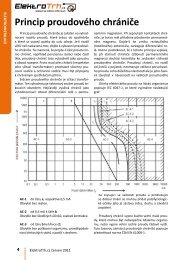2010Annual Report - Schneider Electric CZ, s.r.o.
2010Annual Report - Schneider Electric CZ, s.r.o.
2010Annual Report - Schneider Electric CZ, s.r.o.
You also want an ePaper? Increase the reach of your titles
YUMPU automatically turns print PDFs into web optimized ePapers that Google loves.
4 BUSINESS REVIEW<br />
TRENDS IN SCHNEIDER ELECTRIC’S CORE MARKETS<br />
140<br />
> 1. Trends in <strong>Schneider</strong> <strong>Electric</strong>’s core<br />
markets<br />
Industries and Machine manufacturers<br />
After the sharp contraction experienced between October 2008 and<br />
April 2009 after Lehman Brothers fi led for bankruptcy, provoking<br />
a brutal stop to industrial investment in all sectors, the industry<br />
market and Machine Manufacturers rebounded as sharply in all our<br />
geographic zones.<br />
The rebound began at the end of the second quarter of 2009<br />
and continued and even accelerated in 2010. A mild increase in<br />
our clients’ inventories amplifi ed this growth during the fi rst half of<br />
the year but had no major impact on the year as a whole given a<br />
renewed fall in inventories during the fourth quarter.<br />
The upturn in the market had the greatest impact on OEMs (original<br />
equipments manufacturers) with strong but erratic growth for both<br />
low-end and high-end solutions. This pattern of recession followed<br />
by growth exerted strong pressure on our vendors, particularly of<br />
electronic components, with an increase of lead times during the<br />
fi rst half of the year that had practically been absorbed by the end<br />
of the year.<br />
The emerging markets have already grown beyond their level of<br />
before the crisis, notably throughout Asia and Latin America, in<br />
contrast with Europe, North America and Japan whose exports to<br />
Non residential buildings<br />
Over 2010 as a whole, the Non-residential buildings market declined<br />
again both in the United States and in Western and Central Europe.<br />
In the mature countries, offi ces, stores and industrial buildings, which<br />
depend on corporate investment, saw the sharpest declines, while<br />
administrative buildings, hospitals and schools held up better.<br />
Residential<br />
After two years of sharp contraction, the Residential market improved<br />
worldwide in 2010 before stabilising during the course of the year<br />
in Europe and the United States. In Europe, only the “peripheral”<br />
countries (Spain, Portugal, Greece and Ireland) continued to pursue<br />
steep decline.<br />
2010 REGISTRATION DOCUMENT SCHNEIDER ELECTRIC<br />
the emerging countries have boomed but whose domestic markets<br />
have remained sluggish.<br />
In the water and mining, metals and minerals segments new<br />
investment materialised more slowly, with few new projects launched<br />
given the still-fragile context for fi nancing them, but also with a strong<br />
upturn in the volume of requests for tender during the second half of<br />
the year which augurs well for growth in 2011.<br />
Despite the restriction on new spending, notably in Africa and the<br />
Middle East, environmental constraints were a factor of resilience<br />
given the stimulus both to measure and report energy consumption<br />
and achieve actual reductions in consumption. In response to<br />
government policies, industrialists now seek to improve effi ciency<br />
throughout the production cycle.<br />
For example in the water segment, infrastructure needs helped prop<br />
up demand across the water cycle, from supply and desalination<br />
to distribution and wastewater treatment. Programs are being<br />
developed to optimise and reduce the energy consumption of<br />
these activities. These programs are driven by government policies<br />
and, most important, the obligation to control water prices. Water<br />
operators also increasingly aim to improve the management of their<br />
grids in terms both of security and reduction of waste.<br />
Building permits and starts showed signs of improvement in the<br />
mature countries.<br />
Market growth was stronger in the emerging Asian countries and<br />
South America and increased slightly in Africa and the Middle East.<br />
In the Asia-Pacifi c region the market, which only slowed during the<br />
global recession, managed two-digit growth in 2010. As for the new<br />
EMEAS economies, they remained in recession in Europe, stabilised<br />
in Russia and rose sharply in South America.

















